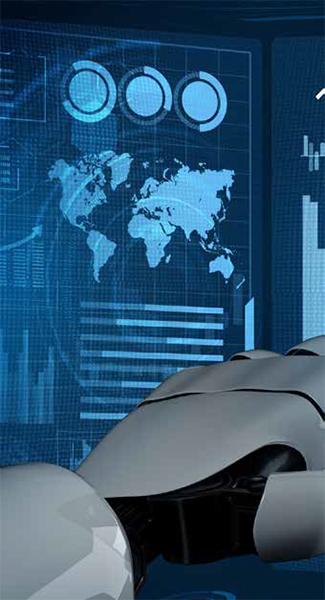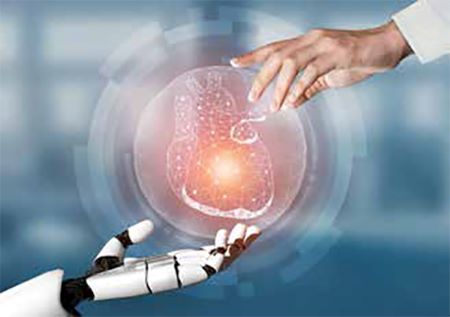The increased use of artificial intelligence (AI) in medicine has not yet permeated the field of organ transplantation. Our current capabilities of predicting patient survival or organ rejection remain limited and require invasive biopsies. Using AI to improve outcomes with non-invasive standard testing through 12-lead electrocardiograms (ECG) has allowed us to predict outcomes after heart transplantation. We continue to expand the research and utilization of this capability in the fields of liver and kidney transplantation.

The explosion of artificial intelligence (AI) in healthcare over the past decade has increased exponentially year over year. Continued advances have made it easier for data-minded and clinically oriented providers to efficiently utilize data with automated research and product development tools. Organizations are now understanding the value of big data and using machine learning (ML) algorithms and other cognitive technologies in the medical setting to diagnose diseases and improve treatment pathways for patients – on the heels of implementing these solutions for billing and revenue capture.
Feeding large amounts of patient data and other linked information through a data analytics platform, helping them to learn independently, and developing a unique algorithm that can recognize hidden or complex patterns for the benefit of patients and institutions is taking shape in many areas across the US and the world.
A key stumbling block, however, has been the development of clinically relevant platforms to help create processes and workflows. Over the past few years, ML has complemented clinical practice in the settings of automated image interpretation and data extraction from electronic health records (think CMS audit) and now begins to enter the realm of precision medicine. Companies have developed and validated ML algorithms and translated them into commercially available tools approved or cleared by the Food and Drug Administration (FDA) for use in clinics. Based on currently available information from the FDA and recently published data, most of these devices and applications remain within the radiology and cardiovascular clinical spaces. However, exponential growth and adoption in the healthcare industry will surely change that over the next decade.

Within the United States and abroad, cultural trends have also highlighted the role of the merger of healthcare and artificial intelligence technologies, namely the Apple Watch and its integration of ML technology to interpret your heart rhythm and record a single-lead electrocardiogram (ECG) to assess for atrial fibrillation. The broader utilization of ML in cardiovascular medicine has been established in multiple settings. In the recent era, ECG analysis has been the most developed machine learning algorithm in cardiology.
A key reason for the continued growth of AI techniques used in cardiology can be directly associated with heart failure. New heart failure patients are diagnosed at a staggering rate of nearly 550,000 per year in the US. Admissions and readmissions have continued to increase, despite programs focused on decreasing them from 2010 – 2017 between 18 and 31%. Despite expanding the use of ML in cardiac diseases – end-stage heart failure and organ transplantation have not been a critical priority. Artificial intelligence in predictive medicine has not yet blossomed within the field of organ transplantation. As such, the progression of disease burden is not something intervenable by AI, at least not yet. Considering this and the extensive use of AI and ECG, we at Mayo Clinic in Florida have used this to optimize outcomes of the sickest patients – those necessitating heart transplantation. Understanding the nuanced interactions of the neurohormonal cascade, environmental factors, and patient-specific genetic mutations remain out of reach for many practitioners, data sets, and ML capabilities.
Our unique position at Mayo Clinic, with large data sets, blood banks, and genomic information, allow us the capability to develop new and innovative models. The current practice for predicting organ rejection after heart transplantation remains barbaric. We are utilizing catheters with ‘jaws’ on the end to sample donor heart tissue as the standard of care. Novel methods of cell-free DNA from blood work exist but are in infancy, without significant adoption when looking at highvolume transplant centers. Using AI to improve outcomes with non-invasive standard testing through 12-lead ECG has allowed us to begin to understand what is involved in predicting, with some accuracy, outcomes after heart transplantation.
Our preliminary proof of concept data, published and presented at the 2022 International Society of Heart and Lung Transplantation (ISHLT), demonstrated the utilization of ECG after heart transplantation to establish for the first time a new parameter – Physiologic (Heart) Age (7). Based on this and the recipient’s chronologic age, we determined high-risk or low-risk patient clusters for potential rejection based on our retrospective data. As this is a hypothesis-generating study, the results of which are helping future providers assess for risk of potential post-transplant rejection – future studies comparing ECG prediction and biopsy results will shed light on the possible use of this in real-time; for example – imagine your patient using a 12-lead hand-held or Apple watch based ECG, remotely transmitted to an on-call provider – enabling the highly accurate prediction of potential rejection based on patient symptoms and the initiation of upstream management of medical therapy and interventions – a possibility in the not so distant future!
Moreso, the pathway forward is not only prolonging life, but early intervention to prevent organ failure. End-organ damage after progressive heart failure is a cascade that continues to topple over time. Machine learning interventions using patient data have allowed us to understand the potential for temporary mechanical circulatory support devices (tMCS, e.g., Impella, ECMO, and TandemHeart) and the potential for both cardiac and non-cardiac organ recovery. Cardio-renal syndrome, a large swath of patients with progressive renal failure after heart failure, is a crucial area for this technology to be applied. Renal replacement therapy with dialysis allows for increased survival for some but significantly decreases the quality of life.
Early patient-based real-world case series from our center demonstrates the ability for tMCS in six patients with end-stage heart and kidney failure awaiting heart transplantation to exhibit renal recovery – not requiring heart and kidney, but only heart transplantation – which is known to affect their short- and long-term survival. Understanding clinical factors that may not have previously been elucidated with conventional research highlights a standout characteristic of ML in medicine.

Increased access to data with collaborative partnerships remains the last mountain to climb. Understanding the benefit of multi-Institutional data, varied populations, and increased diversity within similar disease states will only help underscore common trends – detected through machine learning – applicable to all patients. These new diagnostic criteria may allow us to evolve beyond those factors that, as providers, we use today to predict diagnoses and therapeutic responses.
Limitations in increasing the survival of patients beyond that of currently available traditional medicine drive the field of organ transplantation and regeneration towards a future that has the potential to break the barriers of current survival while maintaining both quality and quantity of life. Artificial intelligence integration within the practice of transplant medicine can potentially optimize post-transplant survival. Further translational projects continue to progress toward the demonstration of validity and safety in the clinical setting. Financial burdens of innovation, ethical considerations, and regulatory organization policies will hopefully navigate this future in a way that can create an equitable application of artificial intelligence for both diagnostic and therapeutic applications – while keeping the innovation fires burning as more and more promising results are seen – impacting both patients and providers alike.
References:
1. Benjamens, S., Dhunnoo, P. & Meskó, B. The state of artificial intelligence-based FDA-approved medical devices and algorithms: an online database. npj Digit. Med. 3, 118 (2020). https://doi.org/10.1038/s41746-020-00324-0
2. Zhu, Simeng, et al. “The 2021 Landscape of FDA-Approved Artificial Intelligence/Machine Learning-Enabled Medical Devices: An Analysis of the Characteristics and Intended Use.” International Journal of Medical Informatics, vol. 165, 2022, p. 104828., https://doi.org/10.1016/j.ijmedinf.2022.104828.
3. https://www.apple.com/healthcare/docs/site/Apple_Watch_Arrhythmia_Detection.pdf
4. Attia, Z, et al “Application of artificial intelligence to the electrocardiogram.” European Heart Journal, vol 42, 2021, p 4717–4730, https://doi.org/10.1093/eurheartj/ehab649
5. Khan, Muhammad Shahzeb, et al. “Trends in 30- and 90-Day Readmission Rates for Heart Failure.” Circulation: Heart Failure, vol. 14, no. 4, 2021, https://doi.org/10.1161/circheartfailure.121.008335.
6. Goswami, Rohan. “The current state of artificial intelligence in cardiac transplantation.” Current opinion in organ transplantation vol. 26,3 (2021): 296-301. doi:10.1097/MOT.0000000000000875
7. Ruiz Morales, J., et al. “Artificial Intelligence 12 Lead ECG Based Heart Age Estimation and 1-Year Outcomes after Heart Transplantation.” The Journal of Heart and Lung Transplantation, vol. 41, no. 4, 2022, doi:10.1016/j.healun.2022.01.1671.
8. Sathvik BS, Parthasarathi G, Narahari MG, Gurudev KC. An assessment of the quality of life in hemodialysis patients using the WHOQOL-BREF questionnaire. Indian J Nephrol. 2008 Oct;18(4):141-9. doi: 10.4103/0971-4065.45288. PMID: 20142925; PMCID: PMC2813538.
9. Jang, Ji-Min; Nativi, Jose; Patel, Parag; Leoni, Juan C.; Yip, Daniel; Sareyyupoglu, Basar; Landolfo, Kevin; Pham, Si; Goswami, Rohan. REN3: Percutaneous Axillary Temporary Mechanical Support Improves Renal Function Prior To Heart Transplantation In Patients With Chronic Kidney Disease. ASAIO Journal: June 2022 - Volume 68 - Issue Supplement 2 - p 89 doi: 10.1097/01.mat.0000841208.11864.3b